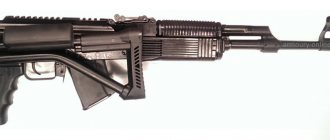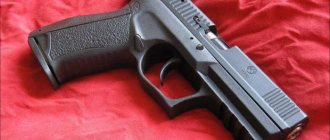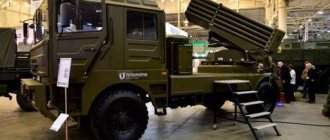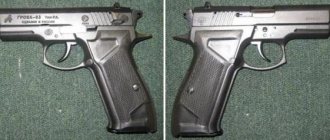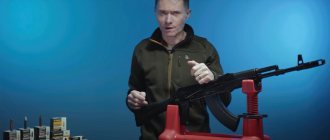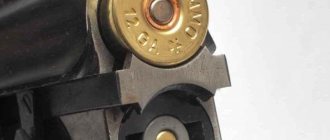Lancaster and Paradox are methods for drilling a barrel, the main part in small arms. It is also called a channel . In the models they are basically the same in design. Samples may have differences in the chambers and the design of the rifling or grooves that wind in the bore. Manufacturers create them in directions - right or left. This does not change the energy and accuracy much, but the bullet will deflect when rotating along the rifling. This section gives the charge movement, in which it flies and rotates like a top.
Lancaster
An oval screw drill was developed and implemented in metal in 1850 by gunsmith C. Lancaster . Since that time, the method has been named after him and a production patent has been received. With such cutting, and there are only 2 of them, the processed edge goes into the field, which makes it look not like a circle, but an oval. The configuration of the figure directs the movement of the bullet not along a straight path along the channel. The charge makes turns according to the number of grooves. Thanks to the acquired torque, the accuracy of hitting the target increases . In rifled rifles, the exit shape has a standard raised cross-section, which is absent in the Lancaster.
This indicator gave the weapon significant advantages:
- Easy maintenance due to the absence of lead on the channel for a long period, quick cleaning occurs with minimal attention, saving time for initial shooting.
- The performance for shot shots and the accuracy of bullets have been increased.
- Areas of a smooth trunk increase its strength and reduce the weight of the object.
- Friction forces decrease, projectile speed increases.
- Maintaining the initial torque has a positive effect on accuracy.
You can visually imagine Lancaster using the example of a water pipe , if it was flattened and the cross-section became oval instead of round. The object is then rotated along the axis. According to GOST, the type of drilling is classified as a smooth-bore weapon. For a threaded channel, screw grooves or grooves must be present. There are no such grooves in Lancaster. The characteristic feature is confirmed by a certificate; the product is purchased under a license intended for smooth-bore equipment.
Lancaster drilling: no great success
PHOTO KESARA RATHNAYAKE/FLICKR.COM (CC BY-ND 2.0)
Unfortunately, the miracle did not happen; the results were interesting, but not so impressive.
Despite this, drilling has taken root, but not on ordinary smooth-bore weapons, but on small calibers that are close to rifled weapons.
Let's try to figure out why this happened, whether a breakthrough in the characteristics of smooth-bore weapons could be expected and why Lancaster is popular in small calibers.
First, let's get acquainted with the history. To begin with, the first mention of an oval drill dates back to 1808, 50 years before Lancaster patented his drill. William Greener, in his book "Gunmaking in 1858", wrote that Captain Beaufoy in 1808 published an opus called "Scloppetaria", in which he described the oval drill and depicted a tool for cutting it.
He indicated the advantages and disadvantages of such cutting, but, unfortunately, it is not known whether experimental samples were made.
Lancaster himself registered his invention on January 16, 1851, receiving British patent No. 13454, which describes the production of firearms, cannons and shells.
In 1853, “Improvements in the manufacture of cannons and other firearms” were patented in the United States (No. 9830 dated July 5, 1853). The American patent described in detail the technology and equipment for oval drilling, including channel finishing.
Almost simultaneously with it, British patent No. 1988 dated August 27, 1853, with similar content, was received.
Read the material “Izh-27 with Lancaster drill”
Interestingly, the oval drill was originally intended for the production of cannons and rifles, that is, it was essentially “rifled” and had to compete on equal terms with this type of weapon.
As we see, in the patents and descriptions of Lancaster’s contemporaries there is not a word about shooting with shotguns. At the time of invention and later, this type of drilling was proposed as an alternative to a rifled barrel.
Compared to rifled weapons, it had a number of advantages. An oval-shaped barrel was easier to make; standard bullets fit it, unlike, for example, Whitward's polygonal drill, and therefore the weapon was cheaper.
And it was easier to care for him. And this is important, especially for muzzle-loading weapons using black powder.
In addition, oval drill bits are less susceptible to wear and therefore durable.
| The idea behind the Lancaster drill is to simplify the rifled barrel. The profile of the trunk remains smooth, but has an oval cross-section, and this oval twists around its axis along the trunk. Such a device makes it possible to twist the projectile on one side, and on the other, it reduces the resistance exerted by a standard rifled barrel profile. |
But let's return to the patent. Most of it is devoted to the method of cutting an oval drill:
“The gun is fixed on a longitudinal frame, which slides and moves back and forth...
The shaft (1) with the cutter (2) works eccentrically in a pipe (3) of the same diameter as the gun barrel before cutting; the cutter is mounted on the inclined surface of the wedge-shaped part (4) of the rod (5), which runs from end to end through the pipe and is moved using a wrench and a nut (6) fixed externally at the end of the pipe.
Read the article “Do you need a license for a gun with a Lancaster drill?”
The gun on a movable frame is moved by a screw driven by a driving device until the cutter and pipe come to the breech; then the cutting tool is set in motion, the pipe and the eccentric shaft of the cutter begin to rotate in opposite directions; the cutter is gradually positioned so as to gradually deepen the cut, at the same time the cut is given a helical turn by rotating the gun around its axis...
| The first Lancaster drill rifles were still muzzle loading. |
Joint rotation in opposite directions with equal angular velocities of the pipe that fixes the cutting tool in the barrel bore, and the shaft with the cutter, eccentric relative to the axis of the pipe (and, accordingly, the axis of the barrel), makes it possible to obtain a cut in the form of a regular ellipse in cross-section.
The horizontal movement of the barrel simultaneously with rotation around its axis forms the channel itself. This movement with the help of a screw (7) is created by a frame with a traverse (8), in the spindle of which the breech end of the barrel is fixed.
The opposite end is hung on another traverse in a rotating device (9), the guide of which (10), moving along the template rail (11), ensures rotation of the barrel.”
As we can see from the description, a barrel with an oval drill is in origin and historically close to a rifled one; its ovality is created by a cutter. It is also clear from the patent that there is no talk of any hunting weapons - only guns and rifles.
Read the material “The agony of choice: gun or rifle?”
Weapons with oval drilling were not widely used; only a few companies produced military rifles and hunting rifles.
One of them - the Henry Thorne company - made mainly rifles of “rifled calibers” in .256, .303, .360, .400, .450, .500 and .577, single-barreled rifles in calibers .250, .300, .360 and . 380.
But in addition to rifles, they also had shotguns of shot calibers (with or without an ejector) for black powder 20, 16, 14 and 12 calibers called Colindian.
This is probably the first time that oval drilling has appeared in “smooth” calibers.
| Experiments with oval drilling in hunting rifles were carried out more than a hundred years ago. PHOTO NATIONAL FIREARMS MUSEUM |
Experience with using oval drill bits for shotguns of smoothbore calibers has shown that they are not very effective when shooting shotguns. Of course, you can live with this: a gun with an oval drill shoots a good bullet. But we have to compromise.
With Lancaster drilling, guns shoot a bullet much more accurately, but the trajectory of the bullet, of course, cannot be compared with the trajectory of a bullet of conventional rifled calibers. And at the same time, due to the twisting of the shot in the barrel, such a weapon has a wide scree and can rarely reliably hit game at a distance of more than thirty meters.
One way or another, by the beginning of the 20th century, Lancaster drilling had become a rarity and was supplanted by the traditional form of rifling.
In fact, it continued to be used in “smoothbore” calibers, but it did not have much success there either. As a universal drill, the Paradox drill took hold, and Lancaster almost disappeared.
| One of the latest versions of weapons with an oval drill was the Mosin rifle for caliber 9.6/53. |
At the beginning of the 21st century, Izhmekh remembered it and began producing a version of the MP-27 shotgun with 20- and 12-gauge barrel blocks with Lancaster drilling.
The highlight was that this drill, thanks to the peculiarities of our legislation, was certified as “smooth”. Weapons with it are considered smooth-bore, and five years of experience are not required to purchase them.
As I wrote above, very high hopes were placed on him. Unfortunately, practice has shown that this drilling does not provide much advantage for large calibers. Not even that.
| RIFLE PROFILE OPTIONS: 1. Three grooves, wide margins. 2. Five narrow grooves and wide fields. 3. Oval Lancaster drill. 4. ?Four grooves, fields and grooves of approximately the same width. 5. Five polygonal rifling. 6. Six rifling, segment type. |
| In the world of weapons, there are a large number of rifled ones. It is interesting that according to our legislation, Lancaster drilling refers to smooth-bore weapons, while in its characteristics it is closer to rifled weapons. PHOTO BY ANTON ZHURAVKOV |
To realize the “rifled” advantages, other speeds are needed, and, accordingly, pressures, which cannot be safely achieved with smooth-bore weapons. Therefore, the maximum that could be squeezed out of the Lancaster was slightly better accuracy and, as a result, an increase in the range of reliable target destruction.
Different experiments indicate different numbers, but the most plausible distance is 100 meters.
The topic with Lancaster had already begun to become a thing of the past, when suddenly a completely new “smooth” cartridge 366 TK appeared, based on a 7.62x39 sleeve, with a nominal caliber of 9.5 mm. At first they made weapons for it with a Paradox drill, but such a solution cannot be considered successful.
Read the material “New weapons released: undercut or advanced shotgun of .366 TK caliber”
Judge for yourself. Almost all weapons produced are semi-automatic (based on AKM and SKS); the bullet first goes along a smooth section of the barrel, accelerates in it, passes through the gas outlet and crashes into the rifling, causing an extremely unnecessary pressure surge and an extra load on the reloading system. Lancaster fits into this scheme much better.
Considering that weapons with oval drilling are still certified as smooth-bore, new models seriously claim to occupy the niche of smooth-bore weapons (for those who did not particularly want a smooth-bore weapon, but are simply waiting out the five-year period before rifled ones).
| Today, the oval profile of the barrel is produced by forging on rotary forging machines. This method is less labor intensive. PHOTO SHUTTERSTOCK.COM |
This weapon is not an ersatz weapon, but a real one, and in some characteristics superior to its prototypes. Suffice it to say that the power of the new .366 TK cartridge is almost 20% higher than that of its progenitor in 7.62x39 caliber.
It is clear that this weapon can successfully replace a carbine when hunting in forest areas - a kind of “Russian stopper” for the middle zone.
The prototype of the new .411 caliber was the 7.62x54 cartridge. The new cartridge surpassed its parent and even our favorite cartridge 9.3x54 in power. Today, a Mosin rifle is available for this cartridge, and also under a “smooth” license.
Read the material “Gun owners may be required to wear identification marks”
Looking at all this, I can’t help but wonder how objective it is that a weapon is considered smooth?
As you can see, Lancaster drilling has come a long way from cannons and rifles, tried its hand at smooth-bore weapons, but eventually returned to rifles.
Apparently, this drill is still closer to a rifled weapon, and it is in it that it makes it possible to realize all its advantages.
Alexander Mishin February 5, 2022 at 09:26
The meaning of Paradox according to Fosbury drilling
Paradox is the name given to the muzzle rifling in hunting rifles . Design features increased the accuracy of bullets and left the charge for hunting with shot. This kind of drilling was patented by D. Fosbury in 1885. It is similar in depth and width to fittings.
The gun was designed for hunters in colonial environments dominated by the Asian jungle. We met there not only harmless birds, but also dangerous large animals. We needed equipment that could quickly exchange shot for cartridges capable of hitting the enemy with high accuracy.
It is noteworthy that the method of drilling and the model of weapon produced by the Holland company are called “paradox”. The first Russian rifles with such drilling belonged to zoologist and gunsmith S.I. Buturlin . In practice, his design ideas were used in 1900 in 24-caliber shotguns, close to express rifles.
The charge of “paradox” is endowed with characteristic features:
- The parameters are similar to a regular bullet.
- Conical shape.
- It has leading belts filled with material made of stearin, paraffin, wax or wrapped with a greasy thin rope.
Hunters give preference to rifled weapons - carbines, rifles. Paradoxes gradually lost their relevance, production fell sharply. Copies of previous years' releases are found on the market as rarities. Although production workers argue about the prospects of such cutting. The Russian legislator defined “paradox” as a smooth-bore weapon if its rifled part is no more than 140 mm .
Lancaster blows a hole in gun laws
Being between Scylla (Russian weapons legislation) and Charybdis (market demand) pushes domestic developers to completely unexpected decisions and movement, if not directly opposite to the progress of small arms, then often, say, going in a “perpendicular” direction.
As you know, according to the Law on Weapons (Law on Weapons), the market for civilian rifled weapons is seriously limited by the requirement of a mandatory five-year experience in owning a smoothbore for purchasers of a rifled weapon. And gun manufacturers have been making efforts to overcome or bypass this obstacle since the early 90s.
Actually, the expediency of this restriction is by no means indisputable, since smooth-bore weapons, which can be purchased immediately, are even more lethal than rifled ones. This is evidenced, in particular, by American statistics on mass shootings and the ratio of killed to wounded reflected in them. The incidence of the latter in crimes committed with shotguns is much lower than when the killer used a rifle, carbine or pistol.
The short range of effective fire from a “smoothbore” does not make it any less dangerous, since, as, again, police statistics show, the vast majority of fire contacts fall within this distance by a large margin.
However, let's return to the forced tricks of Russian manufacturers. As a first attempt, we can mention the intention to release to the market a smooth-bore Saiga chambered for the M43 cartridge - 7.62x39. However, this option did not receive permission from the Ministry of Internal Affairs.
The next, more successful attempt was the creation of “Mouflon”. This is a 410 caliber weapon, it is made on the basis of the Mosin rifle according to the “Paradox” scheme. That is, most of the barrel is smooth, and a small part (according to the requirements of the law, no more than 140 mm) is rifled. The effective range and accuracy compared to, say, the Saiga-410 have increased somewhat.
However, the weapon did not have much commercial success, perhaps due to the bolt action.
Potential buyers of the “almost rifled” were waiting for self-loaders, preferably in the usual AK version.
The next step was the creation and certification of the “smooth” 366 TK cartridge based on the 7.62x39 cartridge case with a nominal caliber of 9.5 mm, with which old AKs and SKS could be used with minimal changes.
The production of which was established by Molot, and they began to go on sale as VPO-208 and VPO-209, respectively.
These devices show quite a decent fight, comparable to the “original” at distances of up to 150 meters. However, the problems of these carbines immediately made themselves known. The main one lies in the “Paradox” scheme itself. The bullet first travels along a smooth section of the barrel, accelerates in it, passes through the gas outlet and crashes into the rifling, causing an extremely unnecessary pressure surge and an extra load on the reloading system. Moreover, the question is not only about accuracy, which may suffer from this “jerk”. An error in the powder charge, which is what domestic manufacturers very often do: a factory defect or a piece of casing from a previous bullet stuck in the rifling leads to a rupture of the barrel.
Moreover, this happens not only on the “converted” VPO-208-209, but also on the TG-2, and even on the VPO-213 with a massive heavy barrel that has a large margin of safety.
There is every reason to say that the issue is not in particulars, but in the unfortunate combination of the Paradox barrel with what is essentially a rifle cartridge, which has quite a high energy. This became even more clear after the appearance of an even more powerful “smooth” 9.6x53 cartridge, created on the basis of 7.62x54.
The solution to this problem was found thanks to a curious invention of the 19th century. Russian gunsmiths remembered the oval-helical barrel drilling developed by the British gunsmith Charles Lancaster.
A barrel made using this technology has only two wide grooves, the edges of which gradually turn into fields, and because of this, the barrel bore visually appears not round, but oval. In this case, the “oval” twists around its axis, just like conventional rifling, which gives the bullet rotation and, accordingly, better stability, range and accuracy.
Such a device makes it possible, on the one hand, to spin the projectile, and on the other hand, it reduces the resistance that a standard rifled barrel profile provides and, accordingly, provides a higher bullet speed.
In addition, this design of the barrel makes it easier to care for and ensures its strength, which makes it possible to reduce the weight of the barrel.
Despite its undoubted advantages, weapons with oval drilling did not become widespread, and by the beginning of the 20th century, Lancaster drilling became rare and was supplanted by the traditional form of rifling.
But, undoubtedly, the most important reason for domestic gunsmiths to turn to this forgotten scheme was that Lancaster drilling allows, according to domestic legislation, to consider such weapons smoothbore.
However, the term “drilling” is not entirely correct, since barrels are actually made using the rotational forging method, which not only reduces the cost of production, but also gives the barrel additional strength.
In addition, the use of Lancaster drilling made it possible to bring the characteristics of a “conditionally smooth-bore” weapon closer to that of a rifled one.
Judge for yourself: “Tiger” TG3, VPO-220 or VPO-221 Lancaster in 9.6x53 caliber ensures confident destruction of targets at a distance of 250 meters, after which a significant decrease in trajectory begins. Not to mention hunting use, where such a distance covers the needs of almost all types of hunting with a margin, we note that the experience of recent armed conflicts shows that the majority of targets hit by army snipers occurred at similar distances.
To this we can add that the power of the new .366 TK cartridge is almost 20% higher than that of the M43 7.62x39. In other words, the effectiveness and lethality of “smooth-bore” Lancasters at short and medium distances is not inferior to similar models of civilian rifled weapons.
As a result, the five-year experience in owning smooth-bore weapons, which is required to obtain permission to purchase rifled weapons, turns into a fiction and an absurd formality.
How are they similar?
Weapons manufacturers are engaged in the manufacture of various devices for hunting and military purposes. For convenience and effectiveness of hitting the target, options for channels through which the projectile is sent have been developed. Complex and varied profiles in smooth-bore weapons with one caliber require choosing wads, gaskets, bullets for each model of rifle and barrel.
If we consider the weapon from the caliber side, then a common significant feature between the Lancaster and the paradox will be the drilling of the muzzle in terms of shooting quality:
- Allows you to make shots with bullets and shot while maintaining positive indicators.
- Increases distance.
- Despite the processing, the weapon remained smoothbore.
- Improves accuracy and accuracy of hits.
- The mass of the product has been reduced.
- Only part of the channel was cut, the main section remained smooth.
- The absence of reliefs reduces friction forces and increases the speed of bullets.
- Thanks to legal definitions, it is possible to purchase and hunt under a license for this category of guns.
Historically, it so happened that different drilling methods were created in one historical period. Initially, tools with such improvements were not intended to destroy humans, but to hunt wild animals. The aspirations of the creators are the main common feature in the models of all weapons.
Cartridge 366 TKM for smoothbore weapons
366 TKM is a cartridge developed in Russia, created on the basis of the 7.62x39 cartridge case. The case muzzle is expanded to a bullet diameter of up to 9.58 mm. In fact, 0.366 inches is 9.3 mm, but due to the fact that caliber is measured by the fields of the rifling, and not by the rifling itself, the actual diameter of the bullet differs more from the caliber designation. The cartridge uses a primer for a 7.62x39 rifled cartridge and rifle powder. The abbreviation “TKM” hides a tandem of cartridge manufacturers (TehKrim from Izhevsk) and a weapon manufacturer for this cartridge (Molot-Weapon from Vyatskie Polyany).
What happened in the end? The 366 TKM cartridge, due to a heavier bullet and a larger internal volume of the cartridge case, began to develop muzzle energy (up to 2600 Joules versus 2100 Joules for the donor cartridge 7.62x39), the bullet of the new cartridge began to have a noticeably more serious stopping effect, which in hunting conditions short and medium (up to 200 meters) distances gives a more confident target hit.
An important factor was the fact that initially those weapons that were previously available only in rifled form were remade for the 366 TKM cartridge: the Simonov carbine (SKS) and the modernized Kalashnikov assault rifle (AKM).
The calculation of TechCrim and Molot-Weapons turned out to be correct: inexpensive hunting weapons chambered for a new cartridge, the characteristics of which were closer to the characteristics of a cartridge for rifled weapons, hit the Russian market. However, “inexpensive” is relatively applicable to the weapon-ammunition complex. For example, at the beginning of sales in 2016, the SKS rifled carbine cost about 12-14 thousand rubles, and the cartridge for it cost from 8 to 10 rubles. The smoothbore VPO-208, created from SKS, was sold for at least 20 thousand rubles with a cartridge price of 25 rubles. But those who could not have rifled weapons due to their experience had no other choice.
How are they different in comparison?
According to the Lancaster method, rifling is performed with a larger pitch than that of conventional rifled equipment. In one revolution of the muzzle the parameter is 800 mm . This limits the use of all bullets.
Over the "paradox", Lancaster has an advantage in projectile rotation , where the movement starts immediately from zero and continues throughout the channel. The paradox has a negative effect on the charge, which, at high initial speed, can be deformed due to strong impacts on the barrel walls, encountering rifling. This action reduces the quality of accuracy and accuracy of hitting the target and destroys the object.
What is a Lancaster drill?
Charles Lancaster's drill looks like this: in the smooth bore of the barrel there are two opposite semicircular riflings, which are twisted a certain number of turns, just like with conventional rifled barrels. Due to the smooth transition of the rifling into the walls of the bore, it seems that the bore is oval, which is why this rifling is sometimes called “oval-screw”.
Barrel profile with Lancaster drill
This drill was developed for the needs of artillery in 1850, its purpose was to facilitate the loading of muzzle-loading guns and increase the initial velocity of the projectile by reducing friction on traditional rifling. The idea caught on, and such guns were produced until 1900, until they were completely replaced by breech-loading guns.
Barrel with Lancaster drill for light
In the 20th century, there were attempts to manufacture hunting weapons with such drilling - ideally, it would combine good bullet shooting and acceptable shot shooting. But it was not popular, and was essentially produced in single copies for enthusiasts. For example, you can remember the IZH-27 in 12 and 20 calibers with such barrels.
This was the case until 2022, when, in a collaboration between the companies “Tehkrim” and “Molot Arms”, they released the 9.6x53 cartridge and weapons for it. This became the development of the idea of creating a surrogate “pseudo-rifling” weapon based on barrels with “paradox” drilling. The 9.6x53 cartridge turned out to be too powerful for paradoxes, and it was torn off the barrel rifling. It was then that engineers remembered Charles Lancaster’s drill, which, thanks to the quirks of our weapons legislation, is also not legally classified as rifled.
